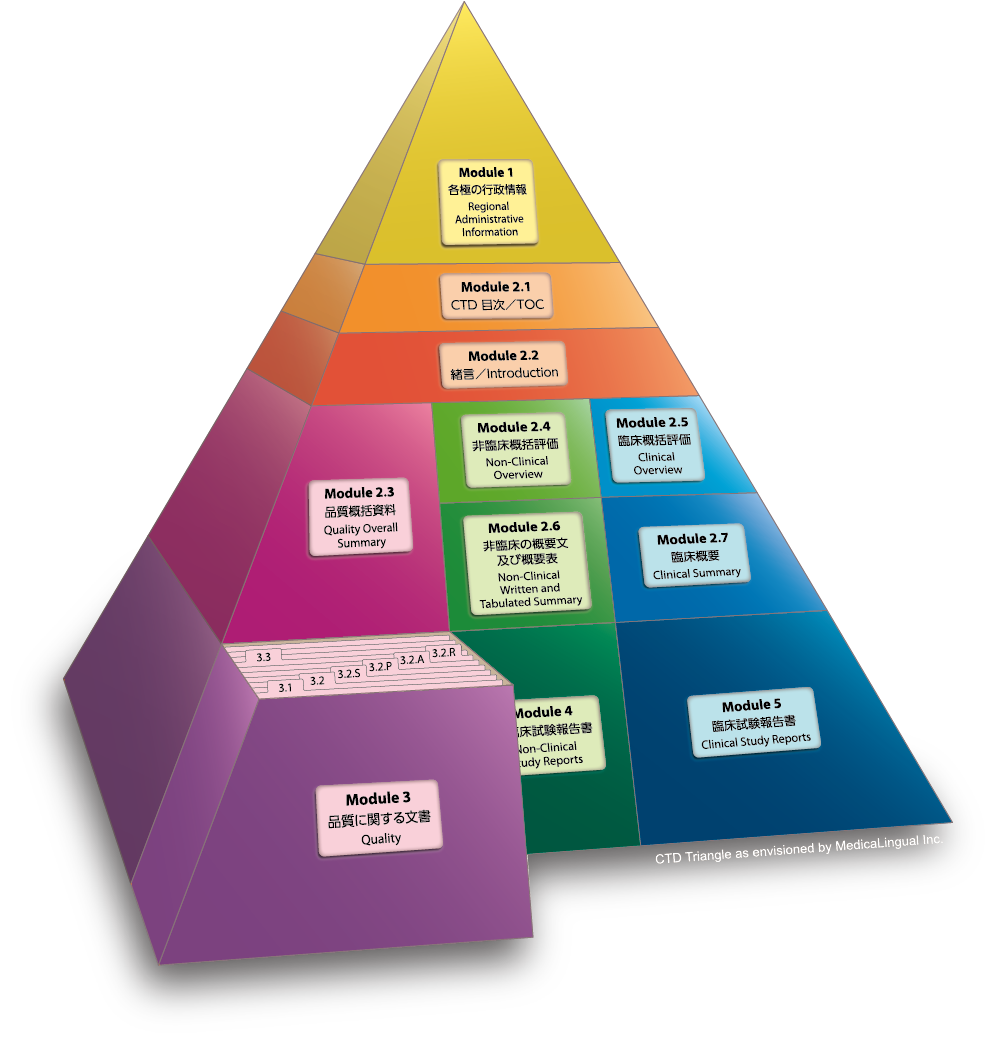
医薬審発第899号 CTD通知(別紙 3)
CTD-品質に関する文書の作成要領に関するガイドライン
(2002年9月11-12日ワシントン会議修正版)
ICH HARMONISED GUIDELINE
QUALITY – M4Q –
(Numbering and Section Headers have been edited for consistency and use in e-CTD as agreed at the Washington DC Meeting, September 11-12, 2002)
Module 3 品質に関する文書
3.2 データ
3.2.A その他
3.2.A.2 外来性感染性物質の安全性評価
外来性感染性物質による汚染の可能性について安全性を評価する資料を示す。
非ウイルス性感染性物質:
非ウイルス性感染性物質(伝達性海綿状脳症関連物質、細菌、マイコプラズマ、真菌等)について、その混入防止及びコントロール法を記述する。これには、例えば、原材料・添加剤に関する証明資料や試験結果などが含まれる。これは、各原材料や添加剤、プロセス及び感染性物質それぞれについて適切な情報であればよい。
参照ICHガイドラインQ5A、Q5D及びQ6B
Module 3 QUALITY
3.2 Body of Data
3.2.A APPENDICES
3.2.A.2 Adventitious Agents Safety Evaluation
Information assessing the risk with respect to potential contamination with adventitious agents should be provided in this section.
For non-viral adventitious agents:
Detailed information should be provided on the avoidance and control of non-viral adventitious agents (e.g., transmissible spongiform encephalopathy agents, bacteria, mycoplasma, fungi). This information can include, for example, certification and/or testing of raw materials and excipients, and control of the production process, as appropriate for the material, process and agent.
Reference ICH Guidelines: Q5A, Q5D, and Q6B
外来性ウイルス:
ウイルス安全性評価試験について本項に詳細に記述する。ウイルス安全性評価試験では、製造に使用する原材料等が安全であり、かつ、製造中に起こりうる汚染の可能性を試験、評価、あるいは排除する方策が適切であることを示す必要がある。
参照ICHガイドラインQ5A、Q5D及びQ6B
For viral adventitious agents:
Detailed information from viral safety evaluation studies should be provided in this section.
Viral evaluation studies should demonstrate that the materials used in production are considered safe, and that the approaches used to test, evaluate, and eliminate the potential risks during manufacturing are suitable.
The applicant should refer to Q5A, Q5D, and Q6B for further guidance.
生物起源の原材料
動物又はヒト起源の原材料(体液、組織、臓器、細胞株等)のウイルス安全性評価に必要な事項を記述する(関連事項について3.2.S.2.3 及び3.2.P.4.5 参照)。細胞株に関してウイルス安全性の観点からの細胞の選択、試験及び評価並びにセル・バンクに関してウイルス安全性上の適格性について記述する(関連事項について3.2.S.2.3 参照)。
Materials of Biological Origin
Information essential to evaluate the virological safety of materials of animal or human origin (e.g. biological fluids, tissue, organ, cell lines) should be provided. (See related information in 3.2.S.2.3, and 3.2.P.4.5). For cell lines, information on the selection, testing, and safety assessment for potential viral contamination of the cells and viral qualification of cell banks should also be provided. (See related information in 3.2.S.2.3).
製造工程の適切な段階における試験
製造工程(細胞基材、未加工/未精製バルク又はウイルスクリアランス試験後の段階等)において行うウイルス試験の選択について根拠を示す。可能な範囲で、試験の種類、感度、特異性、実施頻度についても記述する。製造工程の適切な段階において行う試験によって、医薬品がウイルスに汚染されていないことを確認した結果を示す(関連事項について3.2.S.2.4 及び3.2.P.3.4 参照)。
Testing at appropriate stages of production
The selection of virological tests that are conducted during manufacturing (e.g., cell substrate, unprocessed bulk or post viral clearance testing) should be justified. The type of test, sensitivity and specificity of the test, if applicable, and frequency of testing should be included. Test results to confirm, at an appropriate stage of manufacture, that the product is free from viral contamination should be provided. (See related information in 3.2.S.2.4 and 3.2.P.3.4).
未加工/未精製バルクのウイルス試験
Q5A及びQ6Bに従って実施した未加工/未精製バルクのウイルス試験の結果を記述する。
Viral Testing of Unprocessed Bulk
In accordance with Q5A and Q6B, results for viral testing of unprocessed bulk should be included.
ウイルスクリアランス試験
Q5Aに従ってウイルスクリアランス評価試験を行う際の考え方と実施要領を試験結果及び評価とともに記述する。実生産スケールの製造プロセスと比較したスケール・ダウン・モデルの妥当性、製造設備・資材に対するウイルス不活化・除去方法の妥当性、並びに製造工程がウイルス不活化・除去能力を有することを示す資料を含むこと(関連事項について3.2.S.2.5 及び3.2.P.3.5 参照)。
参照ICHガイドラインQ5A、Q5D及びQ6B
Viral Clearance Studies
In accordance with Q5A, the rationale and action plan for assessing viral clearance and the results and evaluation of the viral clearance studies should be provided. Data can include those that demonstrate the validity of the scaled-down model compared to the commercial scale process; the adequacy of viral inactivation or removal procedures for manufacturing equipment and materials; and manufacturing steps that are capable of removing or inactivating viruses. (See related information in 3.2.S.2.5 and 3.2.P.3.5).
Reference ICH Guidelines: Q5A, Q5D, and Q6B










